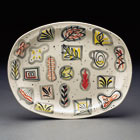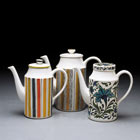In the 1950s, under the leadership of the director Roy Midwinter, the company became one of the leading innovators in British tableware production. A large part of this was due to the noted ceramicists and designers who worked for the pottery, including Jessie Tait, Terence Conran,Hugh Casson, John Russell and Peter Scott. The Midwinter Pottery was also an innovator in producing 'accessories' to their basic dinner services and tea sets. The Clayburn Pottery, a sister company to Midwinter, made pieces such as lamp bases that could be added to a Midwinter dinner service.
The costs involved in developing two unsuccessful new ranges weakened the company, and there was a takeover by J. & G. Meakin in 1968. In 1970 Meakin was itself bought out byWedgwood. Pottery was produced under the Midwinter name from their factory until 1987.
Many of the pieces produced by Midwinter in the 1950s and 1960s have become highly collectible, being typical of the styles of those eras.
Sadly, Jessie Tait died last year, she was a truly amazing woman and was my favourite designer of ceramics. I thought it would be fitting to post her obituary, so I'm starting my blog backwards!! What'e new there.
Jessie Tait, who has died of cancer aged 81, created some of the best known and most innovative ceramic designs of the 1950s. The work she made as chief designer of Midwinter Pottery was characteristic of its time: cheerily and wittily modernist, exuberantly abstract and imbued with the forward-looking visual style of the Festival of Britain.
Despite the handcrafting involved in the manufacture of her pots – they almost always incorporated detail provided by an army of "paintresses" – they were mass-produced and affordable. In the 1990s, the value of Tait's design skills began to be recognised afresh, and her work was valued alongside other significant 20th-century designers such as Clarice Cliff, Charlotte Rhead and Susie Cooper. Tait's work is now sought after and represented in collections including that of the Victoria and Albert Museum.
She was born in Stoke-on-Trent, Staffordshire, the youngest of three children. At the age of 13, she began studies at the Burslem School of Art, in Stoke, where she remained for five years. Perhaps someone as evidently talented from a more privileged background would have ended up at the Royal College of Art; for Tait, the child of a working-class family, the route lay directly into the factories. After a brief and unsatisfactory stint as assistant designer to Rhead, she joined the family firm of WR Midwinter in 1946. Like much of the pottery industry, Midwinter took time to find its feet in the immediate postwar period. A turning point came when Roy Midwinter, the son of the boss, William, took a research trip to the west coast of America, where he observed the sales success of the new, fluid, modern forms by designers such as Eva Zeisel. Chintzy patterns and fussy florals were on the wane. The public wanted something more streamlined, stylish and in keeping with the fresh looks emerging in furniture and fabric design.
 A plate from the Primavera range, in the early 1950s.
A plate from the Primavera range, in the early 1950s.Roy designed a new set of shapes, called Stylecraft, with television-screen-shaped plates and neat, unfussy cups. The range was launched in 1953. Tait took to the new look immediately, creating such patterns as Homeweave, an all-over design resembling a gingham tablecloth laid over the ware, and Primavera, with an exuberant design of abstracted florals. Red Domino, its red rim dotted with white, became one of the most recognisable pottery designs of the 1950s. Innovative abstract designs included Fantasy, which had a central design of swirling lines and spirals recalling motifs by Joan Miró against a grey cross-hatched ground.
The next year a yet more radical shape, called Fashion, was introduced by Roy – it dispensed with the rather nugatory rim on the Stylecraft plate and was even more neat and streamlined. Tait's skill at finding just the right design motif for a particular shape could now flourish – despite her initial fears that the new shape might be too radical.
Festival nodded to the Festival of Britain, its all-over design reminiscent of cells seen under a microscope; Flower Mist is a neat, simple floral design recalling the textile designs of Lucienne Day. Zambesi is one of Tait's most striking designs of the period: a chic zebra-stripe that on some shapes was enlivened by a splash of red.
Aside from the commercial rigours of the mass-produced ware, Tait continued to attend evening classes during the 1950s, making her own tube-lined ware in terracotta and throwing pots. She also made work for the studio pottery Clayburn.
 Coffee pots from the Mexicana, Sienna and Spanish Garden ranges in the 1960s
Coffee pots from the Mexicana, Sienna and Spanish Garden ranges in the 1960sTait continued to produce accomplished work for Midwinter on a range of new shapes introduced in the 1960s. The Fashion shape had begun to look outmoded: in its place came new, cylindrical forms with straight-sided cups. On the elegant, fine shape designed by the Marquess of Queensberry, Tait created chic striped patterns such as Mexicana and Sienna. Her Spanish Garden became a bestseller, its attractive design based on a pattern for a Liberty tie. Her last design for Midwinter was Nasturtium, a brightly orange floral pattern on the Stonehenge shape that was introduced in the 1970s – another range redolent of its time, it evoked a homespun, wholemeal feel.
Midwinter was taken over by Wedgwood in 1970. In the same year Tait married Albert Hazlehurst, a train driver. In 1974 Tait moved to Johnson Brothers, another division of the Wedgwood empire. The creative freedoms of the 1950s would never be replicated in the more corporate environment at Wedgwood, but she continued to produce extremely successful designs.
After her retirement in 1993 she worked as a freelance designer. A deeply modest, practical woman, she never lost the desire to make fresh work. The recognition given to her early designs – which included an exhibition at Richard Dennis Gallery in London in 1997, and Steven Jenkins's book Midwinter Pottery: A Revolution in British Tableware – gave her great pleasure.
Albert died in 1981. Tait is survived by her nieces, Caroline, Henrietta and Rosamund, and her nephew, Charles.
• Dorothy Jessie Tait, ceramic designer, born 6 March 1928; died 14 January 2010.
Over the coming weeks and months I will be posting pictures and insights opinions on Midwinter and other Ceramics from the 1950-60s.
No comments:
Post a Comment